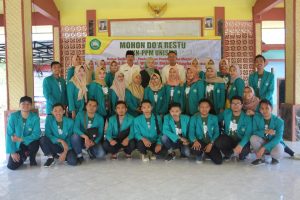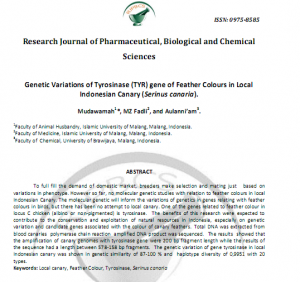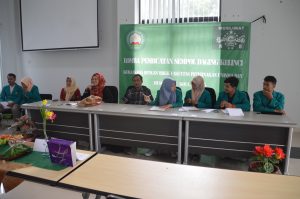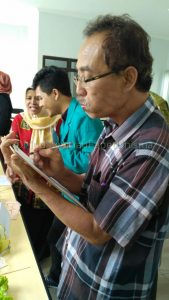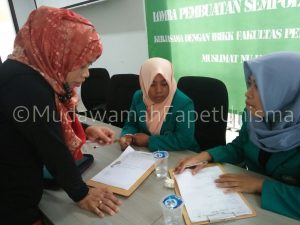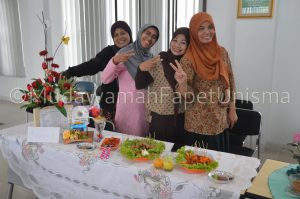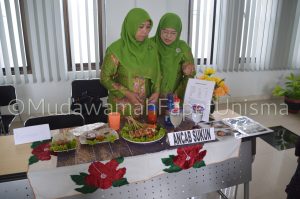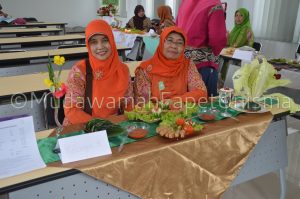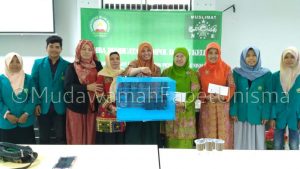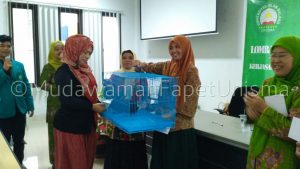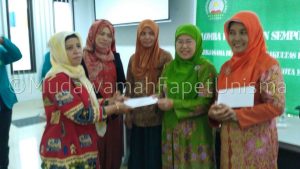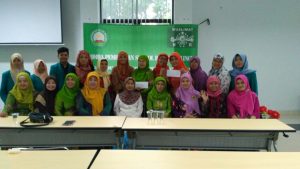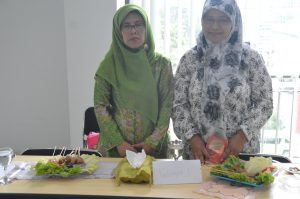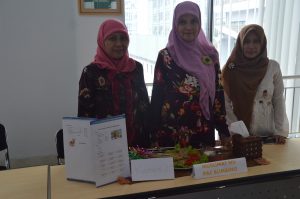Kuliah Kerja Nyata di Desa Bambang Kecamatan Wajak Kabupaten Malang diiukuti oleh 28 mahasiswa, foto pada saat acara kedatangan disambut oleh Kepala Desa Bambang Bapak Sugianto dan Pak Modin, tengah dosen DPL Universitas islam Malang, Dr. Ir. Mudawamah, M.Si. Kegiatan Kuliah Kerja Nyata dengan tema “Identifikasi Potensi Desa Guna Mewujudkan Desa Mandiri” yang akan dilaksanakan pada tanggal 8 Agustus – 8 September 2018
Phenotypic and genetic evaluation of birth weight for F1 crossbred progeny derived from local Indonesian cattle by non-native Bos taurus and Bos indicus sires
Mudawamah1, V.M., Nurgiartiningsih2, A.D. Corebima3, M. Amin3& C.D.K.Bottema4
1Islamic University of Malang, MT Haryono 193, Malang, 65155, Indonesia, 2Brawijaya
University, Veteran, Malang, 65145, Indonesia, 3State University of Malang, Surabaya 6, Malang, 65145, Indonesia, 4The University of Adelaide, Roseworthy, SA 5371, Australia
Abstract
The aim of this study was to estimate phenotypic and genetic parameters for birth weight using two models of crossbreds. The data included the performance of
131 F1 crossbredbetween Brahman sires by Peranakan Ongole dams and 83 F1 crossbred between Limousin sires by Madura dams. DNA samples were taken for 7 % of the progeny. The data were analyzed using ANOVA with SPSS version 15 for phenotypic evaluation. Genetic evaluation was performed included calculating the variance component and heritability estimatesusing paternal half sib correlations. The similarity index of the DNA was analyzed using restriction length polymorphisms (RFLPs) and MVSP software. The least square means of birth weight was 28.58 + 3.50 kg (Brahman x Peranakan Ongole) and 22.50 + 3.00 kg (Limousin x Madura). The effects of crossbreed, sire and sex on birth weight were significant (P < 0.01). The heritability for birth weight was 0.63 + 0.45 and variance component of sire was 2.14. Superiority of F1 to dam at birth weight was 12.52 % (Brahman x Peranakan Ongole) and 60.71 % (Limousin x Madura). The similarity index of DNA between the Fl progeny with its dam was 97.86 % (Brahman x Peranakan Ongole) and 86.71 % (Limousin x Madura). It was concluded that the birth weight of F1 crossbred Brahman x
Peranakan Ongole progeny was significantly higher thanthe F1 crossbred Limousin x Madura progeny. Heritability of birth weight was considered high. The superiority F1 to dam at birth weight and similarity index with Msp I enzyme restriction of the F1 crossbred Limousin x Madura progeny tended to be higher and lower, respectively, than for Fl crossbred Brahman x Peranakan Ongole progeny.
Keywords: genetic evaluation, birth weight, crossbreeding, cattle.
*Corresponding author: V.M. Mudawamah
E-mail address: mudawamah@gmail.com
The Different Calcium+2 Intensity Profile and Quality of Oocyte and Goat Sperms after Cryopreservation
G. Ciptadi1, S. Rahayu2, Fatchiyah2, S. Wahyuningsih1, A. Budiarto1, M. Nasich1, A.R.I. Putri2, M. Mudawamah3 and M.N. Ihsan1
Abstract
This research aims were to study the effect of the oocyte and sperms cryopreservation of Indonesian local goat on the post-thawing quality and profile or characters of Calcium+2intensity in relating with their fertility capacity. A study was conducted to test the freezing method and post-thawing viability both stock cells stored in the deep freezer and liquid nitrogen (-80°C of vs -196°C). A fertility test of sperms has been conducted through in vitro of sperm quality, while the oocytes cryopreserved test was done by in vitro maturation (IVM) rate (%). The profile of Calcium 2+ was performed and analysis by Confocal Laser Scanned Microscope (CLSM). The result showed that IVM rate of goat oocyte is considered lower when cryopreserved in –80°C than in –196°C. Meanwhile, sperm is considered having a good quality in 2 methods of cryopreservation with post-thawing motility > 40 % (SNI 2014). There is an important difference between Calcium intensity of fresh and post-thawing both for oocyte and spermatozoa. Calcium +2 profiles is varied individually on the peak of intensity, but it considered expressed the same profile of each fresh and post-thawing cell. In vitro fertilization test need to be performed to complete the viability and fertility competence of these sperm and oocyte freezing stocks.
A Feasibility Study of Prepubertal and Over Mature Aged Local Goat in Relation to Results of In Vitro Growth Culture to Obtain Additional M-II Oocyte Resources
Gatot Ciptadi 1,a) , M. Nur Ihsan 1) , Sri Rahayu 2) , D. H. K. Widjaja 3) and
Mudawamah Mudawamah 4)
1. Faculty of Animal Husbandry, University of Brawijaya, Veteran Street, Malang, East Java, Indonesia 65145
2. Department of Biology, Faculty of Mathematics and Natural Sciences, University of Brawijaya, Veteran Street, Malang, East Java, Indonesia 65145
3. Faculty of Animal Husbandry, Kanjuruhan University, Malang
4. Faculty of Animal Husbandry, Islamic University of Malang, Malang
a) Corresponding author: ciptadi@ub.ac.id
Abstract. The aims of this research are to study the potential source of mature (M-II) oocytes of domestic animals using follicles isolated from prepubertal and over mature aged Indonesian local goats, resulting from an in vitro growth (IVG) method. This method of IVG could provide a new source of M-II oocytes for embryo production. In Indonesia, a very limited number of a good quality oocytes are available for research purposes, as there is a limited number of reproductive females slaughtered, which is dominated by prepubertal and old mature aged animals. IVG culture systems could be improved as an alternative method to provide a new source of a good quality oocytes for in vitro maturation of M-II oocytes. From a number of prepubertal and mature aged goats slaughtered in a local abattoir, the small oocytes in the preantral follicles were cultured in vitro to normal oocyte growth. The methods used in this research are experimental. Follicles were isolated, cultured in vitro for 14 days individually using a sticky medium containing 4% (w/v) polyvinylpyrrolidone in TCM 199 10% Fetal Bovine Serum supplemented with Follicle Stimulating Hormone, which was then evaluated for their follicle development and oocyte quality. The research results showed that a minimum follicle size and oocyte diameter is needed (>100 um) for early evaluation of maturation to be achieved, meanwhile oocytes
recovered from IVG after being cultured in vitro for maturation resulted in a very low rate of maturation. However, in the future, IVG of the preantral follicles of Indonesian local goat could be considered as an alternative source of oocytes for both research purposes and embryo production in vitro.
view full article
Analisis Kemiripan Genetika Antara Kambing Peranakan Ettawa Hasil Kawin Alam Dengan Inseminasi Buatan Berdasarkan RAPD
ANALISIS KEMIRIPAN GENETIKA ANTARA KAMBING PERANAKAN ETTAWA HASIL KAWIN ALAM DENGAN INSEMINASI BUATAN BERDASARKAN RAPD
Analysis of Genetic Similarity between PE Goats Derived from Natural Service and Artificial Insemination by RAPD-DNA
Mudawamah 1 , I.D. Retnaningtyas 2 , M.F. Wadjdi 2 , Badriyah 2 , S. Susilowati 2 , Aulanni’am 3 , dan Gatot Ciptadi 4
1 Laboratorium Molekuler Halal Center, Universitas Islam Malang, Malang
2 Fakultas Peternakan Universitas Islam Malang
3 Laboratorium Biokimia Fakultas Matematika dan Ilmu Pengetahuan Alam Universitas Brawijaya, Malang
4 Laboratorium Pemuliaan Ternak Fakultas Peternakan Universitas Brawijaya, Malang
E-mail: mudawamah@gmail.com
ABSTRAK
Analisis genetika menggunakan random amplified polymorphic DNA (RAPD) untuk mengetahui kemiripan genetika antara kambing peranakan Ettawa (PE) hasil inseminasi buatan (IB) dan kawin alam (KA). Hasil penelitian menunjukkan bahwa dari 20 primer OPA hanya 10 primer yang bisa digunakan untuk mengamplifikasi fragmen deoxyribonucleic acid (DNA) dalam kelompok kambing PE, yang terdiri atas 21 kambing hasil KA dan 19 kambing hasil IB. Berdasarkan profil DNA yang diperoleh dan hasil analisis dengan software numerical taxonomy and multivariate analysis system (NTSYS) disimpulkan bahwa hubungan genetika antara kambing PE hasil kawin alam dengan inseminasi buatan
adalah sebesar 48% dan dikategorikan rendah.
_________________________________________________________________________
Kata kunci: kambing, PE, RAPD, kemiripan genetika
Short Communication: The normal karyotyping result of Indonesian native breed bull qualified for artificial insemination
Abstract. Ciptadi G, Ihsan MN, Nurgiartiningsih VMA, Ardyah IP, Mudawamah Mudawamah, 2017. Short Communication: The normal karyotyping result of Indonesian native breed bull qualified for artificial insemination. Biodiversitas 18: 1462-1467. Bali and Madura cattle are important native breed in Indonesia, both descendants of wild banteng (Bos javanicus). These breeds are categorized as a small type beef cattle, and are indigenous, well adapted and, have high resistance to diseases. The aims of this research were to analyze dendrograms of these breed and karyotype breeding bull selected for Artificial Insemination (AI). The result showed that the 2n diploid number of chromosome of all cattle was 60 and they were considered normal, based on the number and structure of chromosomes. Fifty-eight acrocentric autosomes and 2 sex chromosome were observed, including a submetacentric X-large chromosome submetacentric and a small Y chromosome. Dendrogram analysis showed that Bali and Madura cattle were closely related and derived more from their ancestor wild banteng than from Java cattle. It is recommended to perform a chromosomal investigation of breeding bulls especially those used for freezing semen production and AI implementation.
Keywords: Abnormalities, Artificial Insemination, cattle, dendrogram, genetic, karyotyping
The normal karyotyping result of Indonesian native breed bull qualified for artificial insemination
Genetic Variations of Tyrosinase (TYR) gene of Feather Colours in Local Indonesian Canary ( Serinus canaria )
Upaya Diversifikasi Pangan melalui Kegiatan Lomba Sempol daging kelinci di Kota Malang Kerjasama IbIKK K&K Fapet UNISMA dengan Muslimat NU Kota Malang Jawa Timur
Upaya Diversifikasi Pangan melalui Kegiatan Lomba Sempol daging kelinci di Kota Malang Kerjasama IbIKK K&K Fapet UNISMA dengan Muslimat NU Kota Malang Jawa Timur.
Persoalan pangan di Indonesia dengan jumlah penduduk lebih dari 100 juta jiwa pada tahun 2016, perlu secara berkesinambungan dicarikan alternatif agar terjadi diversifikasi pangan sehingga ketergantungan yang berlebihan pada satu sumber bahan pangan dapat dicegah.
Salah satu bentuk kegiatan pengabdian pada masyarakat sebagai implementasi dari kegiatan tri Dharma Perguruan Tinggi yang dilakukan oleh Fakultas Peternakan Universitas Islam Malang adalah lomba Sempol daging kelinci antar 5 wilayah di Kota Malang. .
Sempol adalah makanan jenis baru yang sangat terkenal di kota Malang. Bahan baku sempol pada umumnya adalah tepung kanji, terigu , bumbu2, dan daging ayam. Sempol dirangkai dengan tusuk bambu direbus lalu digoreng dengan terlebih dulu dillumuri dengan telur yang sudah dikocok. Cara menyantapnya dengan saus sambal bawang dan cabe.
Sempol daging kelinci yang berbahan baku alami bebas penyedap rasa dilombakan pada tanggal 4 November 2016 di Gedung Abu Bakar Lantai 4 Universitas Islam Malang. Peserta kegiatan lomba adalah ibu-ibu Muslimat NU Kota Malang dari 5 kecamatan yaitu Lowokwaru, Kedung Kandang, Klojen, Blimbing dan Sukun yang masing-masing terdiri dari dua kelompok.
Kriteria pemenang lomba meliputi rasa, tampilan, penyajian, pengolahan (kebersihan dari alat dan bahan), halal (tidak ada barang najis dan haram seperti babi, rambut manusia dll), toyib (semua alat dan bahan yang diperlukan sudah dicuci bersih), ekonomis (total biaya bersaing). Kegiatan ini dinilai oleh 5 dewan juri yang terdiri dari Kaprodi S1 Peternakan UNISMA Bapak Dr. Ir. H. Usman Ali, MP. dan 4 Mahasiswa Fapet UNISMA. Juara satu dengan skor 15,52 adalah kelompok 8 perwakilan dari Muslimat NU Kota Malang Ancab Kec. Klojen, Muslimat NU Kota Malang Ancab Kec. Sukun sebagai juara Kedua dengan skor 15,02 dan Muslimat NU Kota Malang Ancab Kec. Kedung Kandang sebagai juara ketiga dengan skor 14,64.
Kegiatan ini diselenggarakan oleh IbIKK K&K Fapet UNISMA yang diketuai oleh Dr. Ir. Hj. Mudawamah, M.Si kerjasama dengan Muslimat NU Kota Malang yang diketuai oleh Ibu Nyai Hj. Muthammimah serta didukung oleh Ketua Program Studi S1 Peternakan UNISMA Dr. Ir. Hj. Usman Ali, MP. dan Dekan Fapet UNISMA Dr. Ir. Inggit Kentjonowaty, MP.
Dengan munculnya produk sempol ini, diharapkan kegiatan ini mampu memasyarakatkan sempol daging kelinci yang merupakan diversifikasi dari sempol yang umumnya berbahan baku daging ayam di Indonesia khususnya di kota Malang. Selain itu lomba sempol daging kelinci ini juga diharapkan mampu meningkatkan permintaan daging kelinci untuk meningkatkan pendapatan peternak kelinci yang sudah relatif berkembang di Malang Raya.

